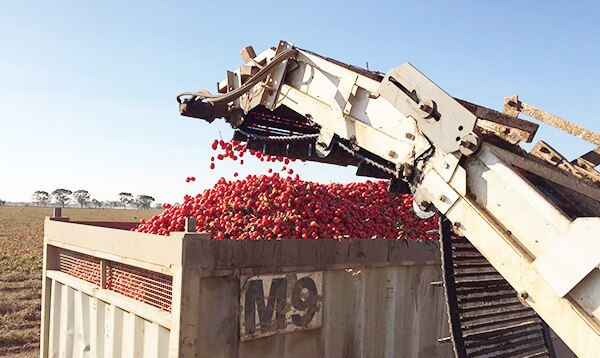Most of us enjoy the great taste of nutritious tomatoes – as pure and fresh crops, tomato sauce, or with pasta. Around 20 million Australians eat 22 kg of processed tomatoes per head annually. Founded in 1899, the Japanese tomato processor KAGOME boasts more than 100 years’ experience in the tomato growing and processing industry. Since 2010, KAGOME Australia’s factory based in Echuca has been cultivating and processing tomatoes, by providing high-quality tomato products to food companies in Australia and other countries. RFID technology from SICK allows KAGOME to ensure product traceability and leads to increasing efficiency in the production process.

On the Echuca fields, KAGOME operates 12 harvesters loading tomatoes into more than 300 huge bins, each with a capacity of 14 tons. Once a bin is full with fresh tomatoes, it is unloaded at a bin pad, waiting for one of 12 trucks to pick it up and take it to the weighbridge close to the factory. One trip from the fields to the KAGOME factory takes approximately 90 minutes and each truck can load three bins – that is an average of Tomatenaround 42 tons of tomatoes per truck. Three years ago, there used to be long truck queues at the weighbridge, and the truck drivers had to wait for 12 minutes until they could get out of the truck to have the tomatoes weighed. As part of KAGOME’s quality control process, three samples from each bin had to be processed in the laboratory because it was not obvious which tomatoes came from a KAGOME farm. In addition to that, the drivers had to prepare paperwork to document the harvesting process as well as the quantity and quality of the yield. This process increases the potential for human error in a paper-based quality control system, which can result in contaminated products reaching the consumer, conceivably creating widespread foodborne illness. So to ensure traceability, it was time for KAGOME Australia to look for a paperless automated identification solution to be implemented at the weighbridge.
Guaranteeing traceability: What is the best solution for identifying tomatoes?
Food traceability is the process of tracking a product’s history and sharing that data along the entire processing path – so-called “farm-to-fork” or “paddock-to-plate” programs. While traceability has always been important for the food and beverage industry, in recent years the need for real-time recalls has increased in Australia, due to plant processing errors or recalls from Food Standards Australia New Zealand (FSANZ). In the ideal case, there is no need for product recalls; however, in the event of a recall, minimizing the impact is a major focus of any food manufacturer’s program of compensation. An effective tracking and tracing program comprises a number of components, starting with accurate and fast identification. For years, the identification workhorse has been the ubiquitous bar code. As foodstuffs move through the production process, they are identified by a unique code; on containers when in process, on packaging for the finished product, on cartons and pallets during transport and on shelves when they finally hit retail stores. The KAGOME specialists were looking for a real-time identification solution that can handle mud and tomato juice as well as heat, wind, and rain.

Streamlining harvesting processes with RFID
RFID technology (radio frequency identification) is increasingly found in food tracing as technology improves and prices come down. Implementation is not uncommon in the case of large containers containing raw products and in the mixing of bulk materials. It offers companies a number of ways to streamline and manage their capacities, focusing particularly on the issues of trace-ability and process reliability. Using wireless technology for identification purposes opens up a new dimension in automatic data recording. The automotive industry has been utilizing RFID for years, where a tag is attached to the car body and is encoded with data options for each vehicle.
RFID tags offer more functionality than bar code technology, as they are read/write devices and no visual contact of the tag is required. Moreover, they are very robust so that they can even survive harsh ambient conditions such as high temperatures, mud, or wetness. In January 2013, KAGOME in-stalled six RFU63x units from SICK, each equipped with three antennas for double stacked bins, at the weighbridge and discharge hill at the factory in Echuca. Resistant and stable RFID tags were attached to the tomato bins, accompanying them right from the start of the harvesting process. As a result, the RFU63x entirely meets KAGOME’s requirements set out for paperless automated identification of tomatoes. In this way, RFID helps to prevent the typical errors made during inbound and outbound goods processes, for example incorrect quantity and quality data, or missing accounting entries.
RFID allows real-time identification of where the tomatoes come from. Due to paperless identification, no truck driver has to leave the truck at the weighbridge anymore and the driver safety is enhanced. This efficiency gain means that the truck is spending less time at the weighbridge and that truck jams in front of the weighbridge and the tomato drop hill have become a thing of the past. As the truck time at the weighbridge has been reduced from previously 12 minutes to two minutes, the truck driver can go for an extra trip per 12-hour shift. This means a productivity gain of 504 tons in total, which is achieved thanks to using the new RFID.
Thanks to the increase in reliable real-time data made available by intelligent identification technology from SICK, KAGOME gained the possibility of making better decisions thereby increasing productivity and efficiency.
Related Posts:
Efficient automotive production with RFID technology
Paper per running meter: RFID technology ensures an accurate production sequence

